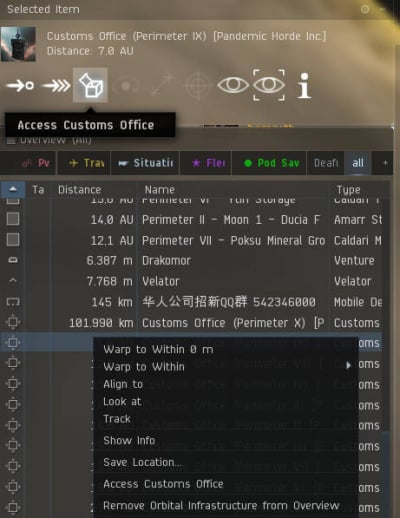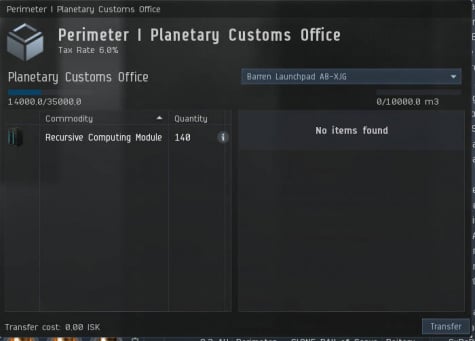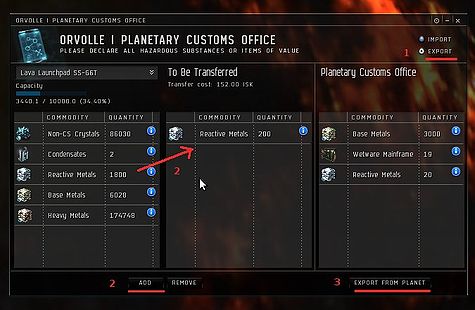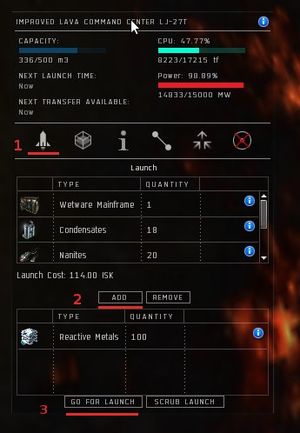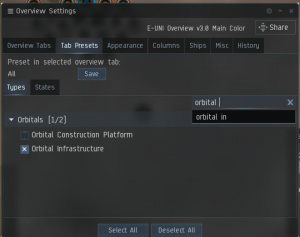Colony management
Colonies are the method in which players interact with planets via Planetary Interaction. Colonies are established by procuring a Command Center the same type as the planet, and landing it on the planet. Doing so will allow you to build other buildings, and link them together for the purpose of mining the raw resources of the planet and producing goods from them.
Contents
Overview
This page details objective specific planet colonies or chains of colonies (while Planetary Industry discusses the usage of putting Planetary Buildings to good use on a single planet)
Colony Types
Colonies at a high level can be grouped into a few different types, though by no means does this limit players to only aim for these setups. Experiment to your heart's content!
Strip Mine
The simplest and most straightforward of the industrial ideology, just a ton of extractors with 1 or 2 storage facilities and a command center. Requires the least micromanagement, but does require reorienting the extractors with new deposits when the current one runs dry, for each extractor. If you use the slower/longer deposits then this setup could run for at least day or two without attention.
Note: The output of this colony may (total stab in the dark - confirm / comment?) strain the capacity of your Command Center to launch rockets with the raw materials, due to the sheer quantity. A Launchpad would cut into productivity, however. This may make the pure Strip Mine colony a rarity versus the similar Mining Complex colony type.
Distributed Strip Mine
A variation on a Strip Mine ideal for very large planets using a high quality Command Center. Large planets like Gas Giants end up with deposits spread far and wide with links that cost as much grid as cpu, eating up your grid much faster than smaller planets. With a ton of spare cpu, with launchpads only costing more cpu and isk than storage facilities (as of this writing), you can simply drop a pile of extractors around each suitable mining spot on the planet and transfer everything to a local launch pad. You'll end up with a planet infected with the measles, but you'll manage to use up your CPU better!
This technique may be more vulnerable to competition than more centralized colonies since it attempts to extract a large amount of the best deposits on a planet.
Mining Complex
Generally the same as a Strip Mine, but with one or more level 1 production buildings thrown in. Hooks the extractors to storage or directly to processors and produces tier one products instead of exporting the raw materials directly. This can be done with a single colony on a single planet, and is probably what most non-dedicated PI-ers will go into, if they don't want to bother shuttling materials from colony to colony to further production. Requires the same attentiveness as a Strip Mine, with the added bonus of dealing with production plants, schematics, more complicated routing, and as such, giving it a tad steeper learning curve.
Since the goal is to convert most if not all raw material to tier one products, the quantity of goods to export is substantially lower than a plain strip mine, and the m3 is likewise lower. This way a Launchpad could likely be avoided. You may have to include storage facilities in the logistics chain to not waste materials due to occupied processors.
Factory Complex
This colony type relies on input from the market or other colonies and as such requires the inclusion of a Launchpad. It will likely be just one planet in a longer chain owned by a single player (or group of cooperating players), though it could also be a standalone turning one product made from market materials into a more profitable market product. Extractors could be added for additional profit, but may eat into the needs for the processors that make up the colony's primary purpose.
High-Tech Composite Plant
This colony is specific to tier four (and maybe five?) products that require both tier one and tier three products. To cut down on logistics, this colony is established on a barren or temperate planet with the raw material for the tier one product component of the desired target product abundantly available. Extractors feed tier one processors that produce that component in-place, and a Launchpad imports the required tier three components for the High-tech processor.
Full Chain System
Multiple colonies built expressly to complement each other make up a full production chain. There are many variations possible, but maybe some more interesting ones can be put here sometime.
Market interaction
Stuff on the market
Interplanetary Logistics
This is about moving stuff between planets. For moving stuff around on a planet see Intraplanetary Logistics
You do not have to setup your entire production chain on the one planet. You can purchase missing products on the market or produce them on other planets. However, then you need to get them down to the surface. In addition, ultimately you will want to get the fruits of your slave ..er "colonists'" labour to market.
These operations must be done in the system, and this exposes you to risk. There are two ways to get goods off a planet (Cargo Link/Customs Office, and Launch Container) and one way to get goods down to the planet (Cargo Link/Customs Office). Many of these operations are done near the "(Planet Name)'s Cargo Link", which you will have to add to your overview. The Cargo Link is like any other container, in that you must be within 2500m to transfer things into and out of it. However it is like your personal hanger in that things placed in it can only be seen by you. Then, unlike your personal hanger, it has a capacity of only 25,000 m3, so can service 2.5 launchpads.
Everything to do with the Customs Office must be done in the system, and in space. While you can perform the Import/Export operations out in the dark at a safe spot (but must uncloak to complete the transfer), you must go to a known location to actually pick up the goods from the cargo link. The Launch Container method, while more expensive, can be done from anywhere in the universe, including docked at a station. However, you will still have to go to the system to pick up your launch can, and others can pick it up too if you don't get there first. (There are some nuances to this: The cans are on directional scan so people can chase them down, get a bookmark from you, or probe you down when you arrive on grid to pick it up. They do not appear with combat probes, so it is a non-trivial process to steal from a launch can.)
The Customs Office window is accessed either by right clicking on the Cargo Link, and choosing Access Customs Office, or from the rocket icon on a Launch Pad.
Importing: To import items to the planet, you must have a Launchpad (found Under Space Port in your list of buildings.) Having built this, the operation is to place the items in the Cargo Link in orbit. Next, right click on the Cargo Link and Access Customs Office. You can then move (or shift-drag to break up stacks) from the Planetary Customs Office pane on the left, to the To Be Transferred Pane in the middle. When you have everything setup to your desire, click on "Import To Planet". The items will arrive in your Launch Pad, and can then be transported elsewhere through Expedited Transfer or Routing. There is a cost of 1 ISK/something to import. Experimental numbers below.
- 150 ISK for 3000 R0 (3000x 0.01 m3 = 30 m3)
- 7.6 ISK for 20 P1 (20x 0.38 = 7.6 m3)
- 90 ISK for 20 P2 Products (20x 1.5 m3 = 30 m3)
- 3,000 ISK for 10 P3 products (10x 6 m3 = 60 m3)
- 25,000 ISK for 1 P4 product (1x 100 m3)
For Export, you have two options: Launch or Export. Export is performed in the same way as Import, by Accessing the Customs Office, and clicking on the Export radio button in the upper right corner. This swaps the positions of the Customs Office and Launchpad such that the Launchpad(s) is/are over on the left. Add items to the shipment, or drag them to the centre "To Be Transferred" pane. When everything is to your satisfaction, click on Export From Planet. There is a cost of 2 ISK/something to export. (ie 8640 ISK for 432,000 R0 (raw materials), 2190 ISK for 2,880 P1 products, 540 ISK for 180 P2 Products, 216 ISK for 18 P3 Products, and 200 ISK for 1 P4 Product. These numbers are chosen from the "compression" resulting from processing.) To spell out the subtext here: Highly recommended to process resources into P1 products, and preferably P2 products before shipping them off-planet, avoid too much shipping of R0, P3, and P4 products.
- 300 ISK for 3000 R0 (43,200 ISK for 432000)
- 15.20 ISK for 20 P1 ( 2,188.8 ISK for 2880)
- 180 ISK for 20 P2 ( 1,620 ISK for 180)
- 6,000 ISK for 10 P3 (10,800 ISK for 18)
- 50,000 ISK for 1 P4 (50,000 ISK for 1)
PS : Use "Access Hangar" to transfer items from your cargohold to the customs office or vica versa
Alternatively, you can launch your products into orbit. This is performed from the Command Center's storage, and so each launch is limited to 500 m3. Click on the rocket icon in the Command Center (insert picture), which brings up the launch drop-panel(?), where you can pick whole stacks to go into the rocket by selecting it and then clicking on the Add button. Once you are satisfied, you can click on launch. It will then launch a package into orbit for you to pickup within the next 5 days. You can find your package and warp to it in your Journal, under the Planetary Launches tab. There is a cost of 3 ISK/something.
- 450 ISK for 3000 R0 (30 m3) (15 ISK/m3, or 0.15 ISK/item)
- 22.80 ISK for 20 P1 (7.6 m3) (3 ISK/m3, or 1.14 ISK/item)
- 270 ISK for 20 P2
- 16,200 ISK for 18 P3
- 75,000 ISK for 1 P4
To create a warpable bookmark (eg if you want to ask someone else to pickup for you), you must warp to the can and bookmark the can. There is no ranged warp available, but you might land more than 2000m from the can, so you may be able to do it without being decloaked. You (and others) can not probe down the launch canister with a combat probe, but they can probe down a ship picking up the package.
Some interesting notes about the Customs Office
- A planet will not have a Customs Office in orbit until one person using the planet has constructed a Spaceport/Launchpad.
- There is only one Customs Office per planet shared between all on-planet.
- Even if you don't have a Colony on the planet you can still use the Customs Office and place items in it.
- It is safe to warp away leaving some of your goods in the Customs Office (no idea for how long however)
Adding the Customs Office to your Overview
To view if a planet has a Customs Office you will need to ensure that Planetary Customs Offices in the section Planetary Interaction is enabled in your overview settings. This will show every Customs Office in the system which will make it easy to determine if a planet is already being harvested by someone else. The "Planetary Customs Offices" can be found under the "Planetary Interation" type.
Player cooperatives
Hippies in space. On planets. In space.
Colony Layouts
Post effective colony layouts here, with classification as to its goal, and, if possible, a cropped picture of the colony layout.
When designing the layouts, note that PINs in the arms can be linked together and only 1 link sent back to the main colony rather than needing to directly link to the destination PIN (eg having a bunch of extractors off away from the command center can be linked one to another, and then only one link goes to the command centre). However, you can only setup a route that makes up to 6 hops.
Also mention the trade-offs between building a link back to your main colony or eating the import/export taxes, CPU/power costs of a launchpad, and lack of automation if you have an isolated sub-colony over on the other side of a very large planet. This is of particular note for a pure mining colony where the export charge was a planned "sunk" cost that you have to pay either way.
- Elite Barren Planet Mining Complex Colony
File:Barrenext.jpg
This is a highsec Barren Planet. There are 18 extractors, 4 processors, 1 command center. 99.35% power grid usage. 5 extractors are for the 2 less abundant resources and 4 extractors are for the 2 more abundant resources. The extractors for a specific resources are separated from each other to reduce depletion of resources but they are group with 1 of each of the other resources to reduce the amount of links required. The extractor clusters are placed where resources overlap. All extractors route resources directly to command center where they are rerouted to processors. The placement of extractors and links were designed so that all resources could reach command center without exceeding waypoint maximums. The processed materials are sent to Command Center for storage until they can be removed from planet. You can remove an extractor from your most abundant resource and add an advanced processor.
